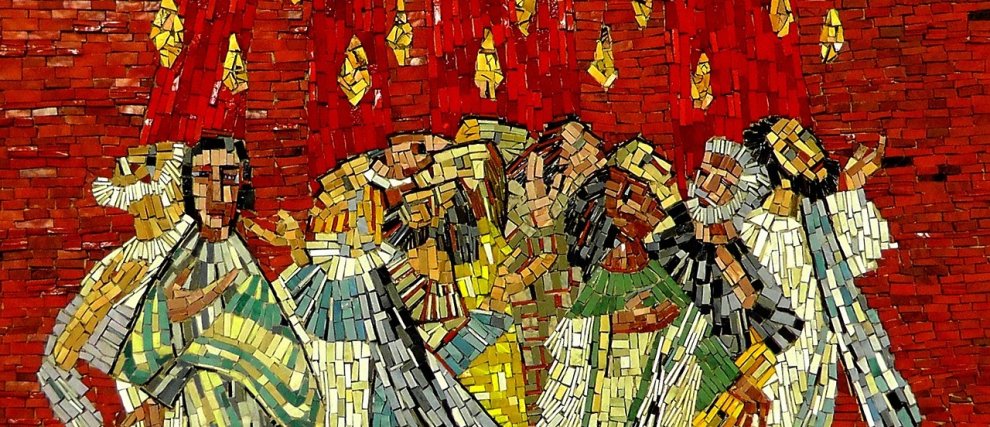The Celebration of Jesus' Ascension
A major Christian festival celebrated forty days after Easter, the Solemnity of the Ascension commemorates Jesus' ascent to Heaven and his entry into celestial glory. Prefiguring the promise of eternal life for Christians, the Ascension is a crucial feast for the Christian faith! It also heralds the coming of the Holy Spirit a few days later.
What is the Significance of the Ascension?
The Ascension: Jesus Ascends to Heaven!
Etymologically, the term Ascension comes from the Latin ascendere, which means to ascend or rise. Therefore, the feast of the Lord's Ascension celebrates Christ's ascent into the glory of Heaven and marks the end of his visible presence on Earth shortly after his death and resurrection.
The apostles, witnesses of this last encounter with Jesus, are however not "left alone": Christ's departure marks a new mode of presence, not visible but universal and timeless! Jesus indeed declares to them: “Surely I am with you always, to the very end of the age.” (Matthew 28:20), signifying his presence in the sacraments, particularly in the Eucharist.
The feast of the Ascension is also for Christians an announcement of the coming of the Holy Spirit ten days later at Pentecost. Indeed, Jesus announces twice to his disciples the coming of the advocate, the Spirit of truth, as he sends them on a mission: “But you will receive power when the Holy Spirit comes on you; and you will be my witnesses in Jerusalem, and in all Judea and Samaria, and to the ends of the earth.” (Acts 1:8)
The Biblical Account of the Ascension
The Ascension of Jesus is clearly narrated by two evangelists - Mark and Luke - while Matthew does not mention it, and John only alludes to it through Jesus' words to his disciples: "I am ascending to my Father and your Father, to my God and your God." (John 20:17). John, however, does not explicitly describe the scene of the Ascension. Thus, the evangelist Mark narrates how, shortly after his resurrection, Jesus appears to his disciples to send them on a mission: “He said to them, “Go into all the world and preach the gospel to all creation. [...] After the Lord Jesus had spoken to them, he was taken up into heaven and he sat at the right hand of God.” (Mark 16:15-20) Saint Luke describes the scene in more detail: "When he had led them out to the vicinity of Bethany, he lifted up his hands and blessed them. While he was blessing them, he left them and was taken up into heaven. Then they worshiped him and returned to Jerusalem with great joy. And they stayed continually at the temple, praising God." (Luke 24:50-53).
In the Acts of the Apostles, Saint Luke provides a second account that deepens the first: “After he said this, he was taken up before their very eyes, and a cloud hid him from their sight. They were looking intently up into the sky as he was going, when suddenly two men dressed in white stood beside them. “Men of Galilee,” they said, “why do you stand here looking into the sky? This same Jesus, who has been taken from you into heaven, will come back in the same way you have seen him go into heaven.’” (Acts 1:9-11).
What is the Difference Between the Ascension and the Assumption?
Although the terms are relatively similar, Christians differentiate between the two terms Ascension and Assumption. The Ascension refers to Jesus' ascent to heaven after his death and resurrection, while the Assumption refers to Mary being taken up into heaven, body and soul, without having to wait for the resurrection of the dead.
How is the Christian Feast of the Ascension Celebrated?
Ascension Thursday: Forty Days After Easter
The feast of the Ascension is always celebrated forty days after Easter: the date varies from year to year, although it always falls on a Thursday between April 30 and June 3 inclusive. It is a public holiday in many countries.
This period of forty days, symbolizing a time of waiting and trial, is very present in the Bible: in the Old Testament, we find the forty days of the flood and the forty years spent by the Hebrew people in the desert after their exodus from Egypt. In the Gospels, the temptation of Christ in the desert also lasts forty days. Thus, the forty days between Easter and the Ascension refer to a period of waiting and spiritual preparation before the solemnity of the Ascension.
Liturgy of the Celebration of the Lord's Ascension
The Solemnity of the Ascension of Christ is one of the main Christian feasts during which the solemn mass of Ascension Thursday is celebrated.
The liturgy of the mass is specific to this day, and the vestments are white, symbolizing the resurrection and glory of Christ. Indeed, the celebration is part of the continuation of Easter, as the Paschal mystery is fully accomplished. By his Resurrection and then his Ascension, Christ “brings our nature with its weakness into the glory of God” and makes us “participants in his divinity.” (Roman Canon)
The liturgy and prayers of the mass continuously remind us of this hope: “God, who elevates Christ above all, open us to joy and thanksgiving because the ascent to heaven of your Son is already our victory: we are members of his body, he has preceded us in glory with you, and it is there that we live in hope.” (Opening prayer of the mass)
Pray with Hozana on the Feast of the Ascension
The Solemnity of the Ascension is constitutive of the Christian faith. Jesus, by ascending to his Father, leaves us free to believe in him and to love him. This physical absence nonetheless carries the promise that he does not leave us alone but sends us a force, the Holy Spirit, so that we too may go on a mission!
Meditate on this great mystery of the Ascension and prepare to receive the Holy Spirit on the day of Pentecost by joining the beautiful prayer communities of Hozana!

